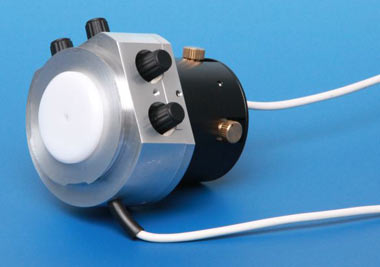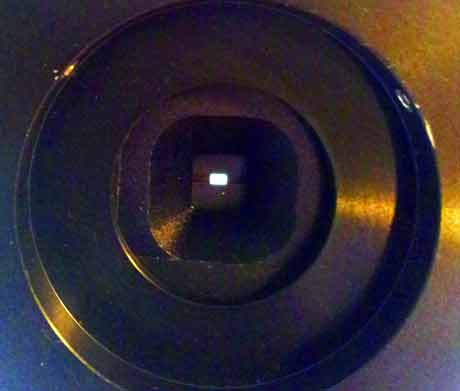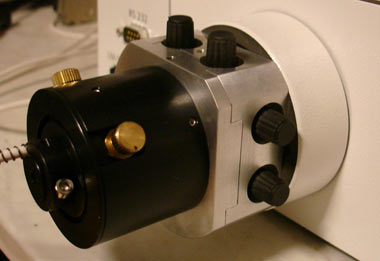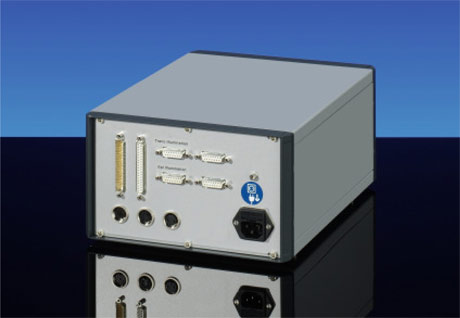Microscope Controlling
Motorized and electronic components for system automation
The reproducibility of a spectroscopic measurement can be significantly improved by automating the processes. For this purpose all manufacturers provide motorized microscope stands. However, functions such as motorized z-focus, electronic coordination of revolvers, TV outputs and the condenser does not affect the spectroscopic result.
Switchable Diaphragms
Very interesting are the possibilities of light management. The adjustments of aperture and luminous field diaphragm are greatly influencing the amount of stray light and thus the dynamic of the signal. With motorized stands diaphragm control and spectroscopy are synchronized. Especially the luminous field diaphragm control is able to accelerate the working process. However, a certain discontinuity will remain, because the diaphragm is a mechanically moving part, which needs time to be moved and the adjustment of which has to be checked continuously.
An alternative is the light management module of A.S. & Co.. It is based on a separation of the illumination types. It positions the measuring light source behind the luminous field diaphragm and an additional light source in front of the field diaphragm. While the measurement unit consisting of field diaphragm and light source does not have to be moved, the sample positioning can be performed over the entire microscopic field of view without loss of contrast using the additional light source.
The system is coordinated by a controller of A.S. & Co.. It can be easily used with any microscope, including also manual stands. As a result, the adjustment of the pinhole (measuring aperture) is performed with such a high precision that diffraction patterns of nanoparticles can be analyzed spectroscopic



DUV light-management-module with integrated pinhole and additional light source for external coupling to the microscope
- the illumination for the spectroscopic measurement of the sample is done via fiber-coupled external lamps.
- synchronization is performed with the A.S. & Co. controller.
- the fiber can be adjusted to the optical axis of the system by a separate x / y alignment.
- a rectangle pinhole is available. The length of each side can be adjusted individually by 4 adjustment srews.
- at a magnification of 1600x, an area <2x2 microns can be illuminated.
- the rectangle shape can be centered exactly in the optical axis of modern light microscopes.
- mounted stationary in the beam path, i.e. no moving parts in the measuring beam path
- the excitation light is precisely focused on the sample
- stray light is prevented
- optimal positioning of the sample while avoiding any misalignments, because there are no parts to be moved in the beam path.
- Measurement of smallest structures,
- Investigations on Dispersed Organic Matter (DOM)
Application Advantages:
Application Examples:
Electronically controlled filters and shutters
The electronic shutters and the ability to control the light intensity are important criteria. Light shutters contribute to the protection of the microscope against high-energy radiation, and support automated dark current measurement. The control of the illumination intensity is possible by modulating the power supply. However this does not meet the demands for spectroscopy. Because for spectroscopy a PC predetermined light intensity has to be established in a reproducible manner within a reasonable time frame and then has to be maintained stable. Otherwise colorimetric changes may result. It is therefore advisable to use a switchable attenuation filter as an alternative to voltage modulation for changing between observation and measurement intensity. If a fully motorized microscope has been chosen, then the integrated filter wheels will solve this task, while the function is not available in a semi-automated one.
For this purpose, the A. S. & Co. automation system provides externally mounted, motorized filter and magnet shutters as an alternative. They are also suitable for manual microscopes or photometers with older electronics, in which the use of current available Control Board's does not ensure success anymore. The results are constant illumination conditions independently of network and electronic variations in reflected and transmitted light. The PC control provides for
- avoidance of damaging UV radiation
- swivelling in heat protection filters for NIR systems in rest
- PC triggered shutting of the beam path in case that prior to each measurement, a new dark current detection should be considered individually.
External Control Systems
Again, the system controller of A. S. & Co. is the central module. It is available in four versions, which in addition to the described uses enable a number of further functions.

Backside of the A. S. & Co. standard controller with plug outputs for integration of system components
© A.S. & Co. GmbH
While the ordinary PC boards and spectrometer cards take only a few options for the basic control, the more complex designed A. S. & Co. stand-alone controller can be expanded with different additional boards. The comparison listed below shows the functional differences.
| Performance | A.S. & Co. Controller Standard | A.S. & Co. Controller Light | A.S. & Co. Controller Board PC | A.S. & Co. Controller Board Spectro |
|---|---|---|---|---|
| Number of auxiliary lights | 2 | 2 | 1 | 1 |
| Control via PC or manually | 2/2 | 2/2 | 1/-- | 1/1 |
| Number of external filter changers or shutters | 2 | 2 | 1 | 1 |
| Number of additional tools (e. g. switching mirror) | 2 | -- | -- | -- |
| External deuterium lamp or deuterium- halogen combination lamp | 1 | 1 | -- | -- |
| External halogen or XBO measuring illumination | 1 | -- | -- | -- |
| TTL XBO-flash control | 1 | 1 | -- | -- |
| Integrated stabilized power supply | 5V, 12V, 15V, 24V | 24V | 5V | 24V |
| Number of circuits | ||||
| D/A TTL out | 12 | 24 | 0 | 0 |
| optional | +24 | -- | -- | -- |
| Analog out | 2 | -- | -- | -- |
| optional | +8 | -- | -- | -- |
| PC coupling | PCI/PCIe | USB2 | USB2 | Ethernet |
| Optional Boards | ||||
| Galvo- Monochromator via Analog Out | X | -- | -- | -- |
| Piezo z-Drive | X | -- | -- | -- |
| AOTF Modulation | X | -- | -- | -- |
| Photomultiplier Integration | X | |||
| Microscope Photometer older version | X |